




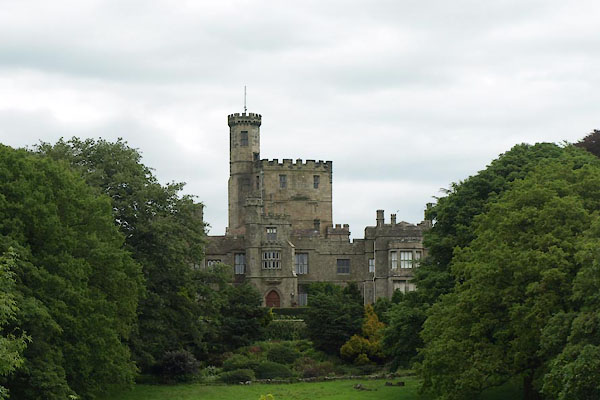
BUU71.jpg (taken 26.6.2011)
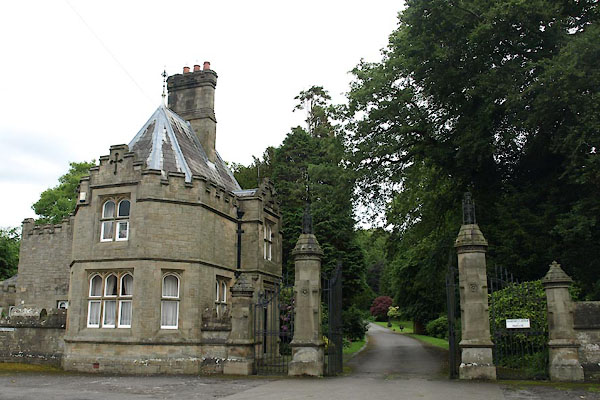
BUU72.jpg (taken 26.6.2011)
placename:- Hornbye Castle
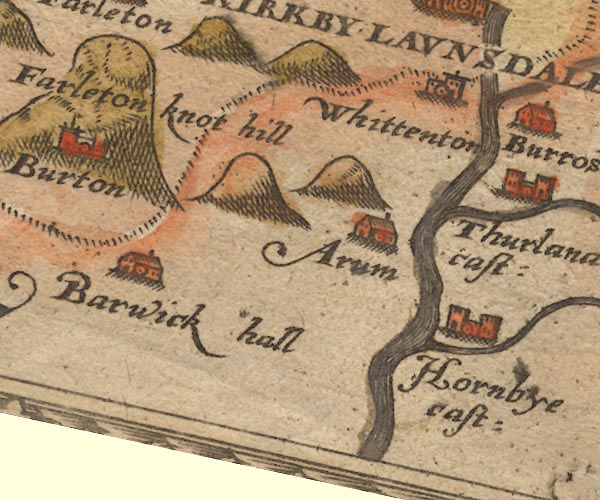
Sax9SD57.jpg
Building with two towers, symbol for a castle. "Hornbye cast:"
item:- private collection : 2
Image © see bottom of page
placename:- Hornbye Castell
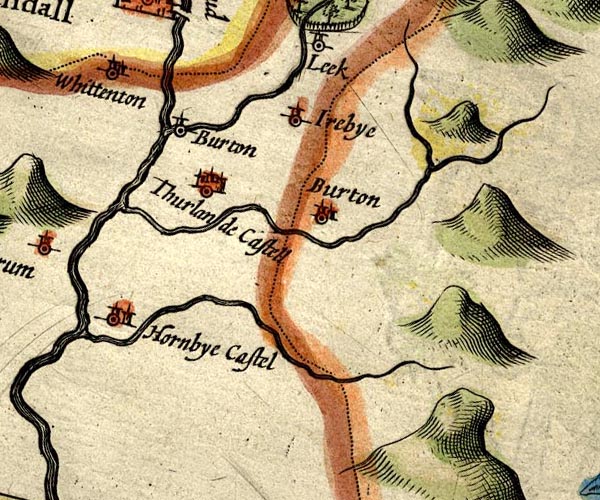
SP14SD67.jpg
"Hornbye Castell"
circle, two towers
item:- Armitt Library : 2008.14.5
Image © see bottom of page
placename:- Hornbye Castle
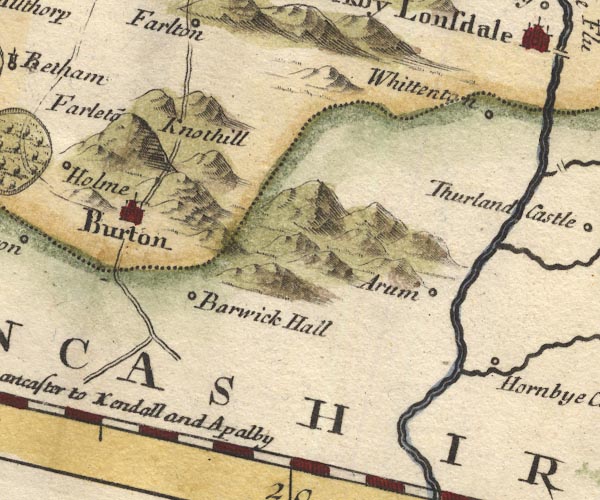
MD10SD57.jpg
"Hornbye Castle"
Circle.
item:- JandMN : 24
Image © see bottom of page
placename:- Hornby Castle
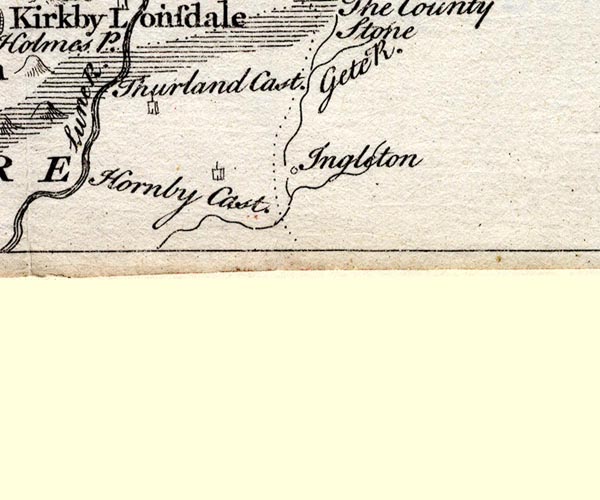
SMP2SDT.jpg
"Hornby Cast."
Building.
item:- Dove Cottage : 2007.38.59
Image © see bottom of page
placename:- Hornby Castle
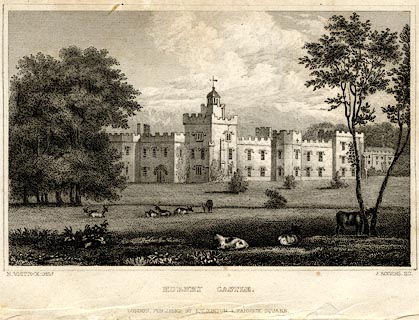 click to enlarge
click to enlargePR0721.jpg
printed at bottom left, right, centre:- "N. WHITTOCK, DELT. / J. ROGERS, SC. / HORNBY CASTLE. / LONDON. PUBLISHED BY I. T. HINTON, 4, WARWICK SQAURE."
item:- JandMN : 298
Image © see bottom of page
item:- summer house
 goto source
goto sourceAddendum; Mr Gray's Journal, 1769
Page 218:- "..."
"... I came to Hornby, ... the castle, in a lordly situation, attracted me, so I walked up the hill to it; first presents itself a large white ordinary sashed gentleman's house, and behind it rises the ancient keep, built by Edward Stanley, Lord Monteagle. He died about 1529, in King Henry VIII's time. It is now only a shell, the rafters are laid within it as for flooring. I went up a"
 goto source
goto sourcePage 219:- "winding stone stair-case, in one corner, to the leads, and at the angle is a single hexagon watch tower, rising some feet higher, fitted up in the taste of a modern summer-house, with sash windows in gilt frames, a stucco cupola, and on the top a vast gilt eagle, built by Mr. Charteris, the present possessor. He is the second son of the Earl of Wemyss, brother to the Lord Elcho, and grandson to Colonel Charteris, whose name he bears."
"From the leads of the tower there is a fine view of the country round, and much wood near the castle. Ingleborough, which I had seen before distinctly at Lancaster to north-east, was completely wrapped in clouds, all but its summit; which might have easily been mistaken for a long black cloud too, fraught with an approaching storm. ..."
placename:- Hornby Castle
item:- Gunpowder Plot
 goto source
goto sourcePage 131:- "... the river Lone passes by ... Hornby, a noble castle, founded by N. de Mont Begon, and owned by the Harringtons and Stanleys, barons Mont Eagle, descended from Thomas Stanley first earl of Derby. The 3d and last of them William Stanley left Elizabeth his only daughter and heiress wife of Edward Parker lord Morley, mother of William Parker, whom king James invested with his grandfather's title of Mont Eagle, and we and our posterity must acknowledge to have been born for the good of the whole kingdom. For, from an obscure letter privately sent to him, and by him most opportunely produced, the wickedest plot which the most accomplished villainy could contrive, was detected when the kingdom was on the eve of destruction, when certain wretches, under the cursed mask of religion, lodged a great quantity of gunpowder under the parliament-house, and waited to fire it and blow up their king and country in a moment."
 goto source
goto sourcePage 140:- "... ..."
""At the foot of Lunesdale is Hornby castle longing to the lord Montegle, half a mile from the Lune. ..."
 goto source
goto sourcePage 174:- "... The site of the Castle was anciently occupied by the Romans. The first structure, of which there are no remains, is attributed by Camden to Nicholas de Montbegon, who flourished about the 12th century, or the 1st of Henry I. The Great Tower was built by Edward, the first Lord Mounteagle, whose name and motto may be seen upon it. The Eagle Tower, which surmounts it, was erected by Lord Wemyss, in 1743; and the late Front by the Chartres family. Within the last few years, it has been newly fronted, and otherwise much improved. Independently of other associations connected with this place, it will be long remembered as the subject of 'The Great Will Cause,' which, commenced in 1826, 'dragged its slow length along' for many a year, wearying out the patience of all: a striking instance of 'the law's delay.'"
 goto source
goto sourcePage 154:- ".."
"Hornby.- On the right is Hornby Castle, the property and possession of the estates attached to which, have latterly been a source of lucrative emolument to the gentlemen of the long robe."
